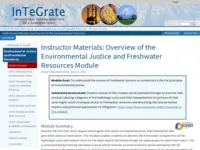https://serc.carleton.edu/integrate/teaching_materials/freshwater/overview.html
Science Education Resource Center at Carleton College
This learning activity takes six 75 minute class periods.
Learn more about Teaching Climate Literacy and Energy Awareness»Grade Level
Online Readiness
Topics
Climate Literacy
This Activity builds on the following concepts of Climate Literacy.
Click a topic below for supporting information, teaching ideas, and sample activities.
Energy Literacy
This Activity builds on the following concepts of Energy Literacy.
Click a topic below for supporting information, teaching ideas, and sample activities.
Notes From Our Reviewers
The CLEAN collection is hand-picked and rigorously reviewed for scientific accuracy and classroom effectiveness.
Read what our review team had to say about this resource below or learn more about
how CLEAN reviews teaching materials
Teaching Tips | Science | Pedagogy |
Technical Details
About the Content
- The major scientific ideas contained in this resource include the hydrologic cycle, fresh water resources, surface and groundwater, hazardous waste, and the connections of these aspects of water resources to people.
- The resource provides opportunities for students to explore real data, both online and in provided materials, from credible sources.
- Although the resource was originally published in 2015, links were updated in 2024 and more recent water data than originally provided was added through a nice feature of the resource, a community collaboration tool.
- The resource provides high-quality background information throughout and the level of rigor is appropriate for the audience.
- Passed initial science review - expert science review pending.
About the Pedagogy
- Learning objectives are clearly stated in each module and the activities lend themselves to students meeting these objectives.
- The resource uses techniques for high engagement such as starting units with interactive components rather than lecturing and using teaching methods such as the jigsaw technique.
- The module contains many interactive activities such as the environment exploration activity in the very first unit, small group work, class discussions, and role-playing.
- For class discussions, the resource provides discussion questions that an instructor could use as prompts. Lecture notes are also included.
- The unit is made up of six lessons, each of which could be taught independently. It specifies that lessons are built for 75-minute classes, but could be taught in less time if certain activities are done as homework. If it is possible to teach all activities in class, that will likely lead to more and deeper discussions.
- This resource engages students in using scientific data.
See other data-rich activities
Technical Details/Ease of Use
- Data and information are built into the module or sometimes linked to, so they are readily accessible. Links to several academic articles are provided, and the resource alerts the instructor that this may be an issue in cases where academic institutions don't have the required journal subscriptions.
- The resource is very well organized, with one activity flowing from the previous one. The resource is highly usable, with excellent guidance for the instructor.
- Unit 1 contains two broken links. These have probably broken recently because links were updated for this resource in the summer of 2024.
- In unit 3 there is some trouble with online formatting of characters in the Hawaiian name for The Four Streams.
- In the Unit 6 References and Resources section, links are not given on the page.








